ESA Unveils Mars Flyover Video Exploring Canyons of Nili Fossae
The minerals detected in this region include silicates, carbonates, and clays, pointing to a time when the region was considerably wet, supporting underground hydrothermal flows heated by ancient volcanoes.

The European Space Agency (ESA) has shared a stunning new video that takes viewers on a flyover of Mars' Nili Fossae region, a landscape carved by the claws of an ancient meteorite impact rather than those of a giant cat. The footage, which reveals a series of deep, parallel trenches, highlights the area's geological and possibly, biological significance.
Formed around 4 billion years ago, Nili Fossae is a remnant of the colossal meteorite impact that created the Isidis Planitia crater on Mars. The impact was so intense that it fractured the Martian crust, resulting in the formation of these trenches, which stretch for hundreds of kilometers. This flyover footage from ESA's Mars Express, which has been orbiting Mars since 2003, provides a three-dimensional view of these ancient "scratches."
Nili Fossae has drawn significant scientific interest because of the abundant and diverse mineral presence indicative of past water activity. The minerals detected include silicates, carbonates, and clays, pointing to a time when the region was considerably wet, supporting underground hydrothermal flows heated by ancient volcanoes.
This rich mineral diversity and evidence of water not only suggest that Mars had a potentially habitable environment in the past but also make Nili Fossae a candidate for future Mars missions. In fact, it was once considered as a landing site for NASA's Curiosity rover, though Gale Crater was ultimately chosen.

